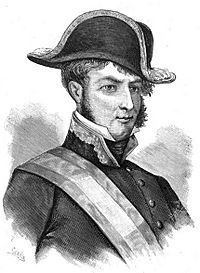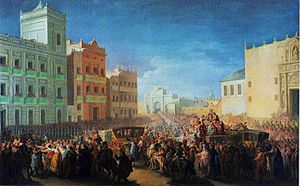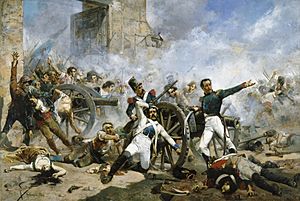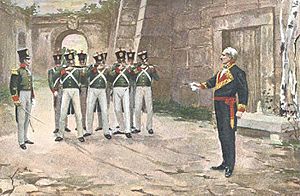Luis de Lacy facts for kids
Quick facts for kids
Brigadier-General
Luis Roberto de Lacy y Gautier
|
|
|---|---|

Posthumous lithography, 1881
|
|
| Born | 11 January 1775 San Roque, Cádiz, |
| Died | 5 July 1817 (aged 42) Bellver Castle, Palma, Majorca |
| Buried |
Cementiri de Sant Andreu, Barcelona
|
| Allegiance | |
| Years of service | 1789–1817 |
| Rank | Brigadier-General |
| Commands held | Capitán-General Catalonia, 1811–1812 Galicia, 1813–1814 |
| Battles/wars | Anglo-Spanish War 1779 to 1783 War of the Pyrenees War of the Third Coalition Invasion of Portugal Spanish War of Independence Battle of Ocana Battle of Barrosa |
Luis Roberto de Lacy (born January 11, 1775 – died July 5, 1817) was a Spanish soldier with Irish family roots. He served in both the Spanish and French armies.
He became well-known during the Spanish War of Independence (1808-1814). This was a big war where Spain fought against Napoleon's French forces. Luis de Lacy held important military jobs during this time. However, he was later put to death in 1817. This happened because he led a failed attempt to change the government of King Ferdinand VII.
Years later, in 1820, the Spanish Parliament (called the Cortes Generales) honored him. They declared him a hero for Spanish democracy. A special plaque was placed in his memory at the Palacio de las Cortes, Madrid, which is still there today.
Contents
Early Life and Family
Luis Roberto de Lacy was born on January 11, 1775, in San Roque, Cádiz, Spain. His father, Patrick de Lacy, was an officer in the Ultonia Regiment. This was a special foreign unit in the Spanish army, originally made up of Irish soldiers.
Luis's grandfather, Patrick de Lacy y Gould, came from Limerick, Ireland. Many Irish people, like his family, left Ireland after 1691. This event is known as the Flight of the Wild Geese. His great-uncle, Peter, became a general in the Russian army. Peter's son, Count Franz Moritz von Lacy, became a Field Marshall in the Austrian army.
Luis's uncle, Francis Anthony de Lacy, was also a famous soldier. He led Spanish forces during the Great Siege of Gibraltar (1779-1783). He later became a diplomat and a Captain-General of Catalonia.
Early Military Career (1785-1803)
Luis de Lacy joined the Ultonia Regiment when he was only 10 years old. His age was officially recorded as 13 to meet the army's rules. It was common back then for children to get military jobs. This often helped provide for orphans or families. Even though the Ultonia Regiment was no longer fully Irish, many officers were Spanish-born descendants of the original Irish soldiers.
In 1789, de Lacy went on a military trip to Puerto Rico. He later fought in the War of the Pyrenees against France. This war ended in 1795.
In 1799, he was sent to the Canary Islands. There, he had a disagreement with the local military leader. This led to a military trial, and he was sentenced to one year in prison.
Service with the French Army (1803-1808)
After his prison sentence, Luis de Lacy was not allowed to rejoin the Spanish army. So, he moved to France to continue his military career. He became a captain in the Irish Legion, a French army unit. This unit was formed to help an Irish uprising against British rule. Many officers in the Legion were Irish or of Irish descent, like de Lacy.
The planned Irish uprising did not happen. So, the Legion was sent to the Netherlands. De Lacy later became a commander in the Legion. He took part in the French invasion of Portugal in 1807.
In 1808, big changes happened in Spain. King Charles IV of Spain gave up his throne to his son, Ferdinand. But then, Napoleon replaced Ferdinand with his own brother, Joseph Bonaparte. Ferdinand was held in France.
De Lacy arrived in Madrid just before the famous Dos de Mayo revolt in May 1808. This was a major uprising against the French. De Lacy left the French army and rejoined the Spanish army. He became a colonel of the Burgos regiment.
Service with the Spanish Army (1808-1814)
In July 1809, de Lacy was put in charge of the Isla de León. This was an important defensive spot in Cádiz, where the Spanish government was located during the war. He led a division at the Battle of Ocana in November 1809. The Spanish army suffered a big defeat there. After another loss at Alba de Tormes, the Spanish army could no longer fight the French in open battles. They started using guerrilla tactics instead. This meant fighting in small groups and using surprise attacks.
The city of Cádiz was surrounded by the French from 1810 to 1812. But with help from the British Navy, the Spanish government could send out small groups of soldiers. De Lacy led these groups in landings at places like Algeciras and Ronda. Even though they couldn't hold these places for long, these actions forced the French to use many of their soldiers to fight them.
In March 1811, de Lacy's troops helped in a joint British-Spanish effort to break the siege of Cádiz. This led to the Battle of Barrosa, a big victory. However, the siege of Cádiz continued.
After the French captured Tarragona in June 1811, de Lacy became the Captain-General of Catalonia. This was the same job his uncle Francis had held years before. The French were busy trying to capture Valencia, which gave the Spanish a chance to fight back. De Lacy led attacks into French areas, which helped boost morale and forced the French to send more soldiers.
Most major towns in Catalonia, like Barcelona and Tarragona, stayed under French control. In early 1812, Napoleon even made Catalonia part of France. The fighting became very harsh, with both sides carrying out attacks and executions. This greatly affected the people living there. Many of the small fighting groups were not under central control and sometimes acted like bandits.
Because of these problems, de Lacy had disagreements with local Catalan leaders. In January 1813, he moved to Santiago de Compostela. There, he became the Captain General of Galicia. He focused on training and reorganizing the army there. After the Allied forces won the Battle of Vitoria in June 1813, the French left Spain. King Ferdinand returned to Madrid in April 1814.
Execution and Legacy

When King Ferdinand VII returned, he decided to rule as an absolute monarch. This meant he had all the power and rejected the Spanish Constitution of 1812 that had been created. Spain also faced wars in the Americas, where its colonies were fighting for independence. These issues made the government unstable.
Many military officers, like de Lacy, tried to overthrow the government. These attempts were often supported by people who wanted more freedom and a modern government.
After two failed attempts in 1815 and 1816, de Lacy returned to Barcelona. With help from a former officer, Francisco Milans del Bosch, he planned another revolt. This began on April 5, 1817, but it quickly failed. De Lacy was captured and sentenced to death by a military court.
There were public protests against his death sentence. So, de Lacy was secretly taken to Palma, Majorca. He was held at Bellver Castle and then put to death by a firing squad on July 5, 1817.
In 1820, another revolt, led by Colonel Rafael del Riego, forced King Ferdinand to bring back the 1812 Constitution. This period was called the Trienio Liberal, a time of more freedom. It ended in 1823 when a French army helped Ferdinand regain full control.
However, in 1820, the Spanish Parliament declared de Lacy a hero. Along with others like Riego, he is remembered on a plaque in the Palacio de las Cortes, Madrid, which you can still see today. Luis de Lacy was buried in the Cementiri de Sant Andreu, in Barcelona.
See also
 In Spanish: Luis Lacy y Gautier para niños
In Spanish: Luis Lacy y Gautier para niños



